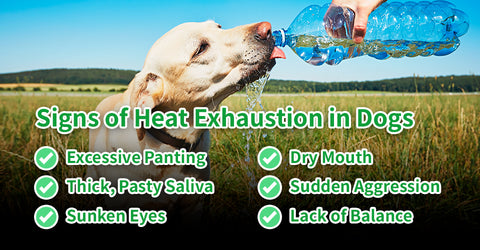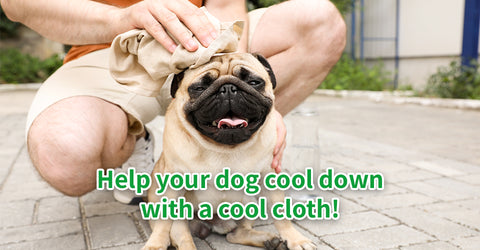
Summer's in full swing and temperatures are soaring all over the country.
How can we keep our dogs safe from harsh UV rays this summer with the sun coming out again? Check out these 4 useful tips!
Now that it’s officially “sun’s out, paw’s out” weather, we’re more than ready to finally get out of the unpredictable spring temperatures to enjoy sitting poolside! But with summertime rolling in, we can’t forget about the harmful effects of UV rays on our skin and our dogs!
Yep, that’s right: the sun’s rays can also affect our dog’s skin, so they need UV protection as much as we do. There are sunscreen brands made specifically for dogs, so be sure to browse online or ask your veterinarian’s office if they carry any product.
We’ll also dig into early signs of heat exhaustion to look out for when your dog is spending the day outside. So let’s have a fun and safe summer with our pups!

Get Dog-Safe Sunscreen
When looking for sun protection, avoid using any sunscreen that is not labeled for dogs. Ingredients found in many sunscreen products are toxic to dogs. These harmful ingredients include zinc oxide and para-aminobenzoic acid (PABA). Because dogs often lick their skin and fur, these toxic ingredients can become ingested by your dog. This is why it’s crucial to use dog-safe sunscreen this summer! In addition, make sure that the dog sunscreen is waterproof with SPF 30.

Dog-safe sunscreen, check! But how do you apply sunscreen on your dog, anyway? And do you have to cover them completely? And what if they’re extra wiggly while you’re applying it?
First, apply a small amount of sunscreen to your dog and wait a few minutes. This quick test ensures that they aren’t allergic to sunscreen. So, if their skin looks good after applying, put the sunscreen on spots that are most exposed to the sun’s rays.
These areas include the bridge of their nose, ears, and the skin around their lips for their face. For their body, apply anywhere where their pigmentation is lighter. For example, if they have less fur - or no fur - in certain areas, use sunscreen. And if their fur coat is thinner in another area, apply sunscreen there. If you want to play it safe and apply sunscreen on their head, be sure you don’t accidentally get it in their eyes.

Wait about 15 minutes for the sunscreen to set in before heading outside.
But if your dog is feeling extra wiggly and won’t sit still while you’re applying sunscreen, do your best to get them to relax. Apply it as gently as you can and talk to your dog to calm any nerves; they may not be used to the feeling of lotion on their skin. And, if they won’t settle down, try to get a little sunscreen on the areas of their body with less fur as quickly as you can.
UV Protective Clothing for Dogs
If you prefer to skip the dog-safe sunscreen, you can always get UV protective clothing to prevent sunburn. You can find this protective dog clothing anywhere online with a quick search, so it’s easy to find.

When browsing for the best UV protective clothing for your dog, look for something they’ll be comfortable in to run around. You don’t want to get them something too snug for their body type, so look for a slightly loose fit.
Solutions for Sunburned Dogs
But what happens if your dog gets sunburned? Don’t worry, accidents happen! Maybe you were outside with your dog longer than you expected, which happens when you’re enjoying a beautiful summer day. So, as soon you get home, give your dog a cool bath with fragrance-free soap to reduce sunburn.

Other easy home remedies include an oatmeal soak, aloe vera gel, or vitamin e oil. For the oatmeal soak, blend one cup of whole oats and mix in a bath of lukewarm water. Then, gently wash your dog’s body in the bath for sunburn relief. If you’re applying a sunburn solution to your dog’s dry skin, you can use aloe vera gel or vitamin e oil to help them heal.

Another way to prevent sunburn is never shaving your dog’s fur coat. This is dangerous because it will only make sun exposure worse for them. A dog’s fur coat, no matter how thick, protects their bare skin from sunburn and actually helps to monitor their body heat. So, if you’re concerned that your dog’s fur is too thick for the summer, consult your veterinarian and a professional dog groomer to find a safe solution.
Signs of Heat Exhaustion in Dogs
While you’re out and about with your pup this summer, be sure to know the signs of heat exhaustion in dogs. It’s one thing to prepare with sunscreen and UV protection, but your dog could still get overheated. The best first step to prevent your dog from getting too hot is to always have cool water on hand for them to drink.

If your dog is panting excessively, this is usually the earliest sign that they’re becoming overheated. This can result in dehydration and heat stress, so give your dog plenty of cool water and head to a shady area. Be patient and wait for your dog to cool off before going on your way.
When a dog’s saliva becomes thicker and sticks to their gums or teeth while panting, this is a sign that they’re getting too hot outside. Because dogs dissipate heat through their mouths, the thickened saliva on your dog’s gums or teeth prevents cool air from reaching the blood vessels in their mouths. If left untreated, your dog can quickly become more and more dehydrated. If this happens while you’re out, all you need to do is wash your dog’s mouth out with cool water.
However, when your dog’s saliva becomes thicker and pasty, this is a sign of heatstroke. But don’t get too worried; just be more aware of this sign to keep your dog safe. Rinse out your dog’s mouth and give them cool water to drink. Allow your dog to cool down and drink plenty of water before continuing on your way. To help your dog cool down, gently wipe their body with a cool, damp cloth.

If your dog’s eyes appear sunken, accompanied by a dry mouth, this is a sign of dehydration and heatstroke. You can best help your dog in this situation by taking them to the veterinarian right away. But, if you’re further away from medical help, you can help tone down your dog’s symptoms. Put a cool, wet towel underneath them so they can lie down. If you have a handheld fan, turn it on to help your dog cool down more.
Always make sure the towel is cool and not ice-cold. The extreme cold can further harm your dog by shrinking their surface blood vessels, which will worsen their symptoms.
When a dog becomes short-tempered or lacks coordination and balance, these are signs of heat exhaustion. So, don’t scold them if they snap at you: find a shady spot and give them cool water to drink.

Keep these tips in mind this summer when you and your dog embark on many outdoor adventures. Having fun is the goal, but being safe should always take priority. Before heading out, give your dog sun protection and bring enough water bottles for the day.




